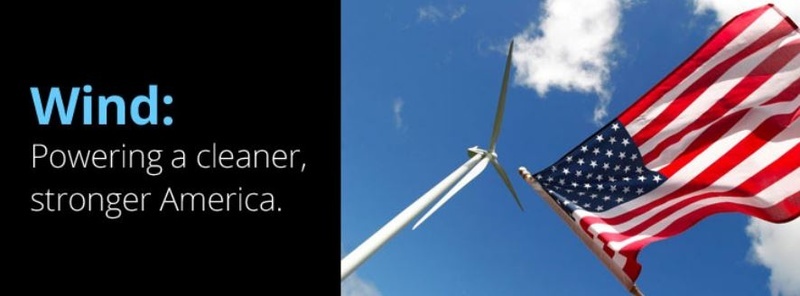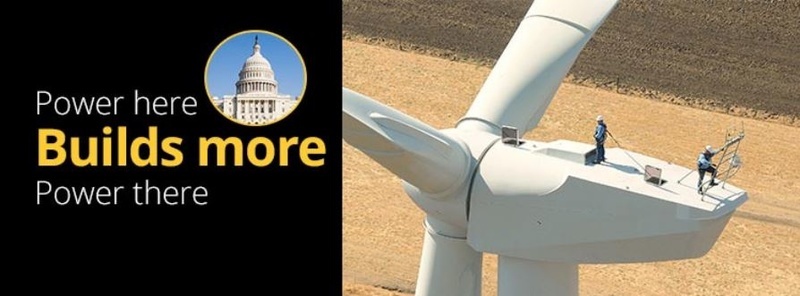News Release from American Clean Power Association (ACP)
Wind Industry Profile of
AWEA Keeping score: Why is a three-week PTC extension worthless?
For the last year, the American Wind Energy Association (AWEA) and bipartisan wind energy supporters in Congress have been clear that the Production Tax Credit (PTC) would have to be extended through the end of 2015 to have any value for the more than 50,000 Americans who work in the wind industry and the 500 wind turbine manufacturing facilities in 43 states. Now that the House of Representatives is considering a three-week extension of the PTC, through the end of 2014, some have gotten confused into thinking that a three-week extension could drive new wind energy development and keep workers on the job. In reality, a three-week extension would be a repeat of 2013, when 30,000 U.S. wind industry workers lost their jobs and there was a 92%, or $23 billion, drop off in wind investment because the PTC was not extended until too late.
That confusion has been partially driven by an inexplicable over-estimation, released late Monday night, valuing a three-week PTC extension at $9.576 billion over the next 10 years, or over $900 million per year. That number was subsequently revised on Wednesday to less than $6.4 billion, which is still many times too high. Those valuations are more consistent with what would be a record or near-record year for the U.S. wind industry. That could be in the realm of feasibility if the House were extending the PTC through the end of 2015. However, it is many times too high for the trivially small value provided by the three-week PTC extension being considered by the House.
As Senator Cardin explained on C-SPAN this morning, the tax extenders bill being considered by the U.S. House of Representatives isn't a "one-year extension, it's a couple week extension." Sen. Cardin added, "there's a better way, it's called the EXPIRE Act,” referring to the PTC extension through the end of 2015 that the U.S. Senate has proposed. A two-year extension would allow the U.S. wind industry to maintain its manufacturing capacity and continue reducing costs, stimulating tens of billions of dollars per year in private investment.
Why is a three-week PTC extension essentially worthless in driving new projects? AWEA has spoken with the leading construction companies that build wind projects, and they’ve explained that it is virtually impossible for a three-week extension to drive new wind development. There’s simply not enough time for any substantial number of new projects to physically begin construction before the end of the year.
Companies we spoke to explained that all of the following steps must be completed before a wind project can begin construction and qualify for the tax credit. Even if all of these steps were started immediately and ran concurrently and without stop through the upcoming holidays, none would still even be close to completion by the end of the year:
1. Geotechnical analysis of wind plant site\: It takes a minimum of 8-12 weeks for geotechnical studies to determine where to best place wind turbines for a project.
2. Wind plant design/engineering: It takes approximately 20 - 25 weeks to draw up the design and engineering plans for a wind project, which must be completed before construction can begin.
3. Pricing and signing contract for wind plant construction: It takes 6-8 weeks for construction companies to obtain and process the information necessary to develop the pricing on a bid to build a wind project, and at least another 2-4 weeks for the wind project owner to review the bids and award the contract after that. Executing the construction contract would then take an additional 3-6 weeks at minimum. In total, this step alone would therefore run at least 11 weeks, and typically closer to 20 weeks. In addition, depending on the specific project and location, there may also be additional time required for obtaining permits for the construction activity, independent engineering review, and additional contract negotiations.
Moreover, there are a limited number of companies with the expertise to conduct any of the above steps, so even if it were feasible to initiate construction on time, there would be insufficient bandwidth for more than a few projects to proceed. Making matters even more difficult is that wind project prospecting and development ground to a halt this year because Congress neglected to extend the PTC before it expired at the end of 2013.
In addition, while projects can also qualify as having started construction by incurring five percent or more of eligible project costs by end of 2014 under the short-term extension moving through Congress, this too is unlikely to drive new development in the next three weeks. While five percent may not sound like a lot of money, in reality, it represents a significant investment and assumption of risk on the part of a project developer, risk and dollars that developers are unlikely to take on for a project without having already lined up a buyer for the power. It would be like you making a non-refundable down payment on a house with no guarantee that you could actually move in -- not a financial move many could afford to make.
Practically speaking, the surest way to achieve that five percent level is signing a turbine supply contract, making payments under the contract, and taking delivery of the turbines in relatively short order as required under the IRS rules for starting construction. This means the developer assumes tens or hundreds of millions of dollars of risk and has to pay millions of dollars in order to meet the five percent threshold. Negotiating and signing such complex turbine supply agreements in a matter of days or weeks and paying significant sums of money for the manufacture of such turbines given the aforementioned uncertainty is unlikely.
Because wind development companies require financial certainty that a project will be moving forward before beginning any of these expensive steps, wind development companies would not begin these steps until the Production Tax Credit extension is signed into law. Even if Congress and the White House were to act immediately on the three-week extension being considered by the House, it would take until April at the earliest before a new wind project could begin construction and qualify for the PTC.
No matter how you cut the math, or how hard you work, it is just not possible to cram the 20+ weeks of work necessary to start wind project construction into the three weeks that would be provided by the House bill.
As AWEA CEO Tom Kiernan explained yesterday, “We call on all clean energy supporters in Congress and the White House to work to pass a two-year extension of these critical tax policies. The three-week extension being considered by the House does not provide the certainty and stability needed to keep U.S. factories open and keep workers on the job. And if you think otherwise, try telling that to the American workers who will be laid off starting in January.”
If you like to receive our Newsletter or find out more about what w3.windfair.net has to offer, please, do not hesitate to contact Trevor Sievert at ts@windfair.net.
w3.windfair.net is the largest international B2B internet platform in wind energy – ultimately designed for connecting wind energy enthusiasts and companies across the globe.
- Source:
- American Wind Energy Association
- Author:
- Edited by Trevor Sievert, Online Editorial Journalist / by AWEA Staff / Michael Goggin
- Email:
- windmail@awea.org
- Link:
- www.aweablog.org/...


